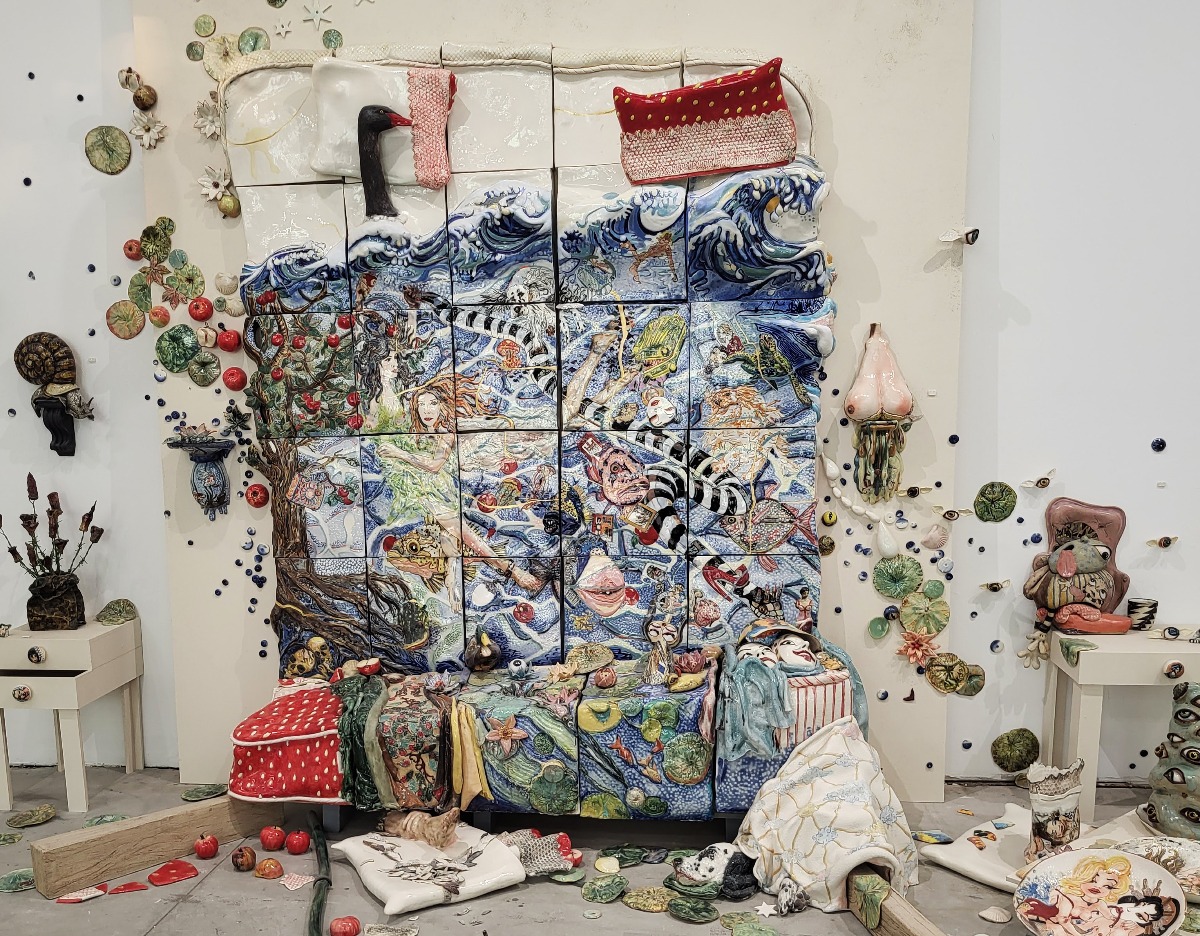
Ceramic Vaginas and Phalluses
Andra Orn*
Politically Charged Erotic Art at the Latvian Pavilion at the Venice Biennale
For me, one of the most significant pavilions of the Venice Biennale this year turned out to be the sensual and playful installation of the artist duo Skuja Braden (Ingūna Skuja, Latvia and Melissa Braden Calfornia, USA). Their work has also been noted as one of the best pavilions in several important art publications.
Usually, something massive and striking is created for the Venice Biennale to catch the eyes of the viewers, but the group of artists, Skuja Braden, approaches from a completely different angle. The Latvian pavilion is designed as a home, centered around a table covered with small ceramic objects of phalluses and vaginas. Is it a reference to the “Lord’s Supper” or a meeting place at home? Another burden is the bed, which is decorated with erotic and lifelike figures in the background of Hokusai’s world-famous work “The Great Wave,” the key figures of which are the authors themselves as mermaids. Does this art shock you? It shouldn’t, the Japanese erotic art of Shunga is part of a very old culture where sexuality was not yet associated with original Christian sin or the term pornography, and sexuality was part of a happy coexistence that was depicted as humorous and full of fantasy.
Approaching the world from an unusual angle could be the keyword for interpreting Skuja Braden’s work. As a curator, I have been trying to find an opportunity to collaborate with them for several years and have not yet been successful at it, but I am happy to analyze the reasons behind their creations. Skuja Braden’s work gives an opportunity to talk about the changing meaning of eroticism over time through shunga art, prejudices, different cultures, and what connects us all.
The pavilion of our southern neighbors at the Venice Art Biennale is like a good book or an intellectual concept – the decorative ceramic works contain references to contemporary politics, fusing digressions from literary and art history, interpreting it all through the personal experience of the authors. The artists’ approach is delicate, poetic, and humorous, which softens the painfulness of the subject without diminishing its importance. The whole display looks aesthetic and uniform. It is not allowed to slip because it is an airy border between eroticism and pornography, a tension that keeps the whole installation together in its rhythm.
The name Skuja Braden denotes the artist duo Ingūna Skuja (Latvia) and Melissa Braden (California, USA), who have been a couple in their personal life for almost 22 years. The LGBTQIA+ issue continues to be problematic in the Baltics (the artists live in Riga), but I would not overemphasize the aspect of sexual minorities. It is strongly present in the space through the artists’ life experience in the form of both erotic scenes and fun breasts, but many other objects are also represented, ranging from decorative plates to functional fountains, from phalluses to snails, adding a complete narrative to the exhibition, passing from one element and narrative to another.
Photos: Raido Krutto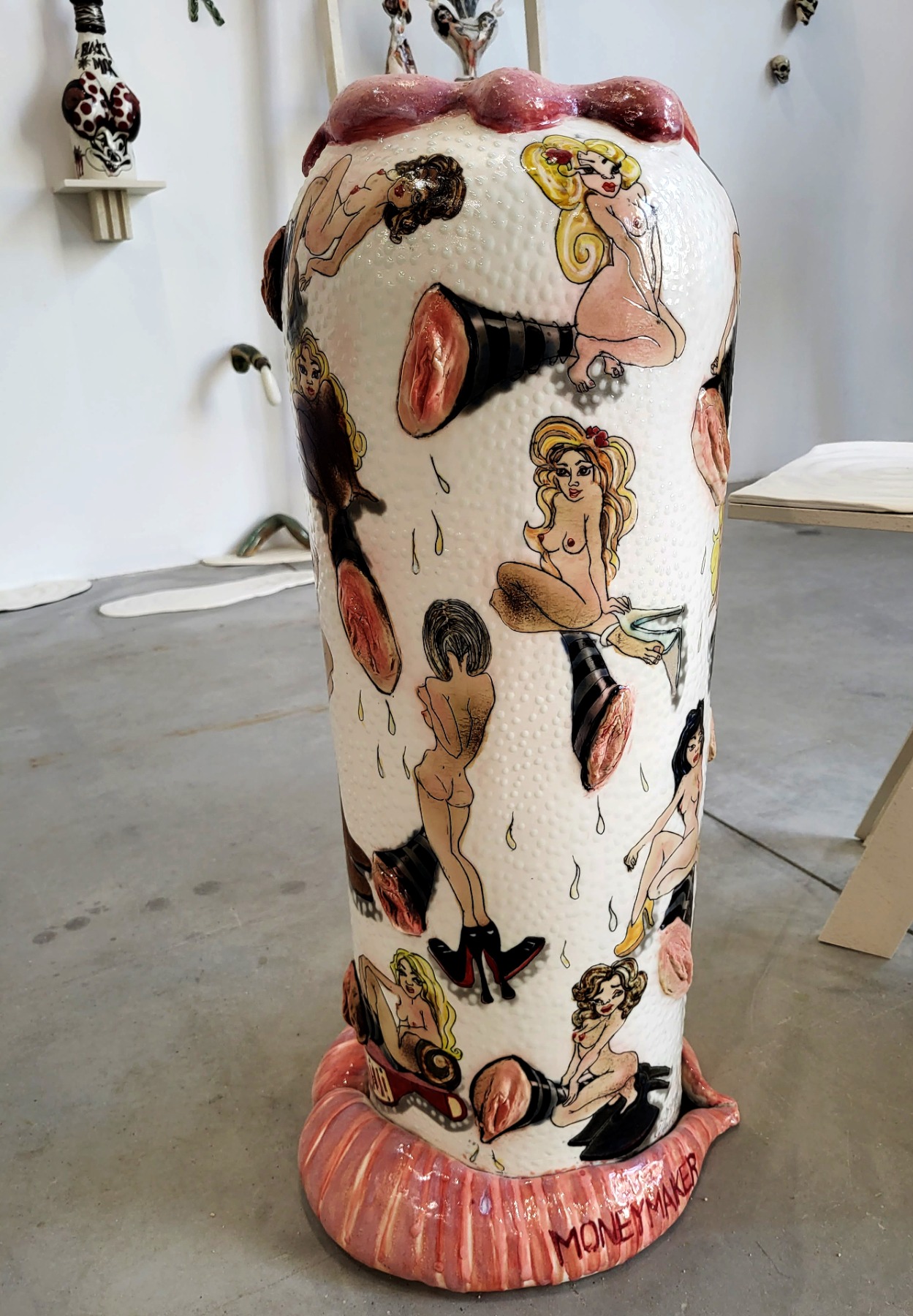
“Selling Water by the River”
The themes of Skuja Braden’s art and life are connected in the installation by water, which dissolves the boundaries not only between private and public but also between nature and home. Water flows through and passes all differences offering a different picture of our being, and water also has a knowing and sublime power. We are all connected on this planet through the flow and continuity of various fluids. The title “Selling water by the river” evokes its own association, but the artist duo has in mind the old Japanese saying about the master who gives the student what he already has but could not find in himself. The past and the present meet together with illusions, religions, and beliefs, providing space not only for a critical review of different ways of reading our region’s history but also for testing the public’s ability to deal with contemporary issues, including military aggression, the polarization of opinions and extreme views, which often collide where different values intersect - in public and private space.
Like excerpts from the home milieu that map our mental and physical areas - bedroom, kitchen, guest room, and those areas where our daily activities acquire ritual meaning, the installation consists of nearly 300 porcelain everyday objects that are on tables, hang on the walls, and are scattered on the floor, attracting attention in their strangeness - plates, cups, vases, lamps, telephones, fountains, snake-like red hoses, and many eyes, vaginas, and phalluses that can also take the shape of a figurative sculpture, which gradually grows into something botanical. Amorphous divine characters seem to come to life in the form of luxuriously painted gods. It is as if it were some mystical altar, where a lot of objects are piled, all of which need separate attention.
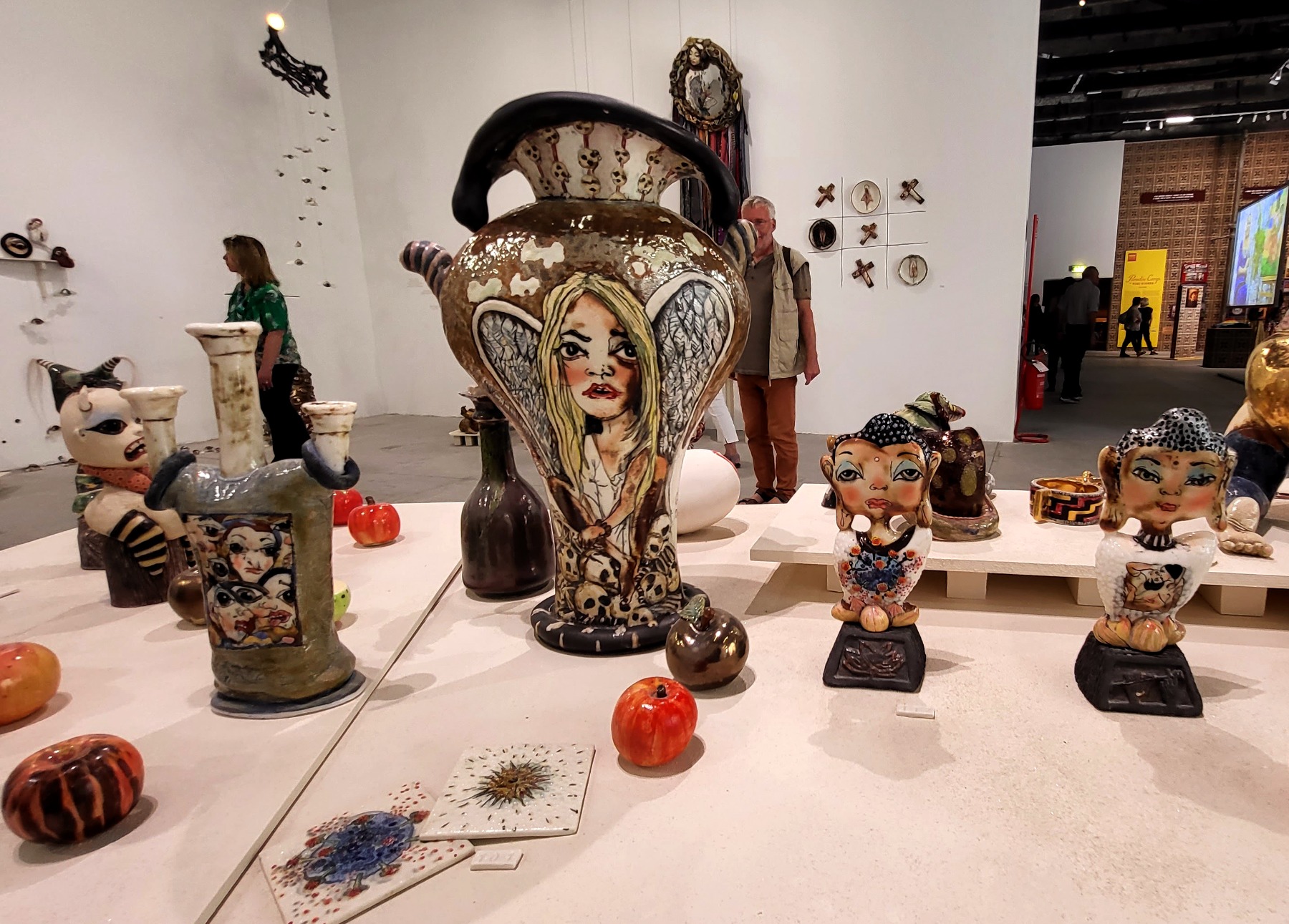
Although the installation is not large, there are plenty of objects to look at, and each of them contains several meanings and details that can only be found after a long look. One gets special aesthetic pleasure from the way one story flows into another, and different world cultures and current topics are reflected in a single key, which is spiced by a nice sense of humor and tact. At the same time, the entire exhibition is sexually tense. Everything is united by the Japanese aesthetics characteristic of the artists, which flows through the room in a calm rhythm characteristic of Zen Buddhism.
“We Made Our Bed”
When entering the Latvian pavilion, the eye is drawn to a large porcelain bed, sensuous and colorful, with Katsushika Hokusai’s world-famous work “The Great Wave” at the headboard. Many know this side of Katsushika Hokusai’s work, but less is known about his erotic art. By visiting the British Museum, an insight into shunga art based on their collection was gained - this knowledge also helps to better understand the structure of Skuja Braden’s work. One of Hokusai’s most famous shunga works is “The God of All Happiness and Intercourse,” which tells about the sexual adventures of two women. The artist duo Skuja Braden has probably not referred to the above-mentioned work but to shunga art more generally, interpreting everything from their own perspective based on acquired practices and personal life experience.
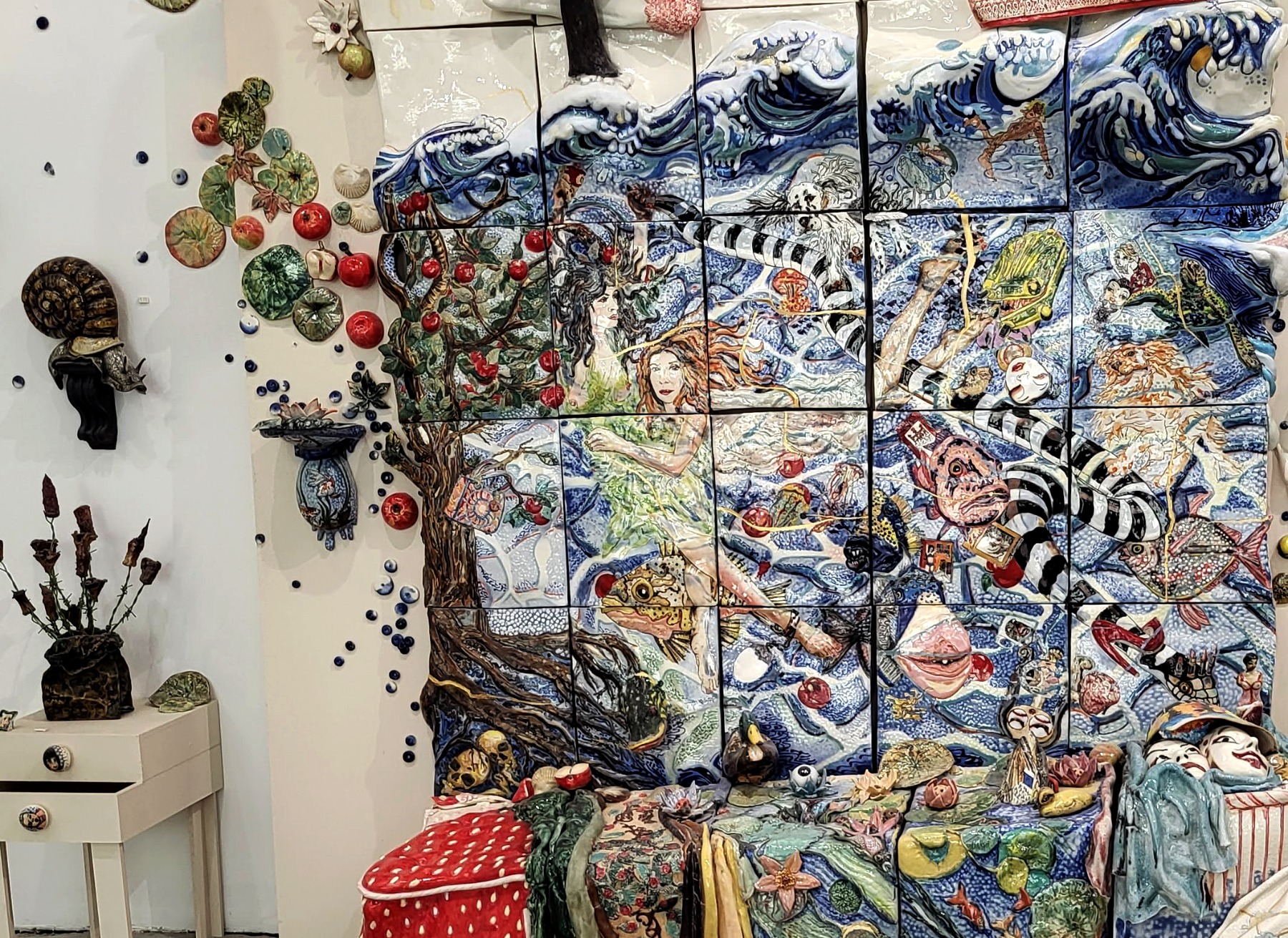
About Japanese erotic Shunga art 1600-1900
Skuja Braden’s work cannot be discussed without the background of Zen Buddhism and Japanese Shunga art. It is very strongly intertwined with the work of the artist duo and gives a more versatile and deeper background to these deep erotic images.
Figures with exaggerated genitalia, stone and clay amulets, wall carvings, and ceramic figurines have been preserved in Japan since prehistoric times. Japanese worship also had an important place in honoring the generative power of the penis, which was considered the basis of good fertility and harvest. People asked for the support of the wooden phallus for help with problems with sexual performance, fertility, or sexually transmitted diseases. Many shrines across Japan still hold festivals where a large phallus is carried in procession. Between 1600 and 1900, erotic paintings, prints, and illustrated books, known as shunga art, began to spread widely.
Shunga was a very large part of Japanese culture until the deepening of trade relations with the West during the Meiji era when the Japanese began to look to the West for administrative and social models through modernization and industrialization. With trade relations came the concept of pornography from the Christian worldview, and eroticism began to be censored. To this day, pornographic images are illegal in Japan, and when sharing shunga images, the genitals are hidden by a black box.
Only now has the period of Shunga art of the years 1600-1900 been considered as a separate direction and artistic style. When in the Christian world of Europe, sexual passion and lust were in the 17th-19th century associated with the fall of humanity and original sin; in Japan, sexuality was considered a part of everyday life to be explored, enjoyed, and celebrated. Shame had no place there, and religious or moral codes applied not so much to sex as to social relationships, which set limits on propriety.
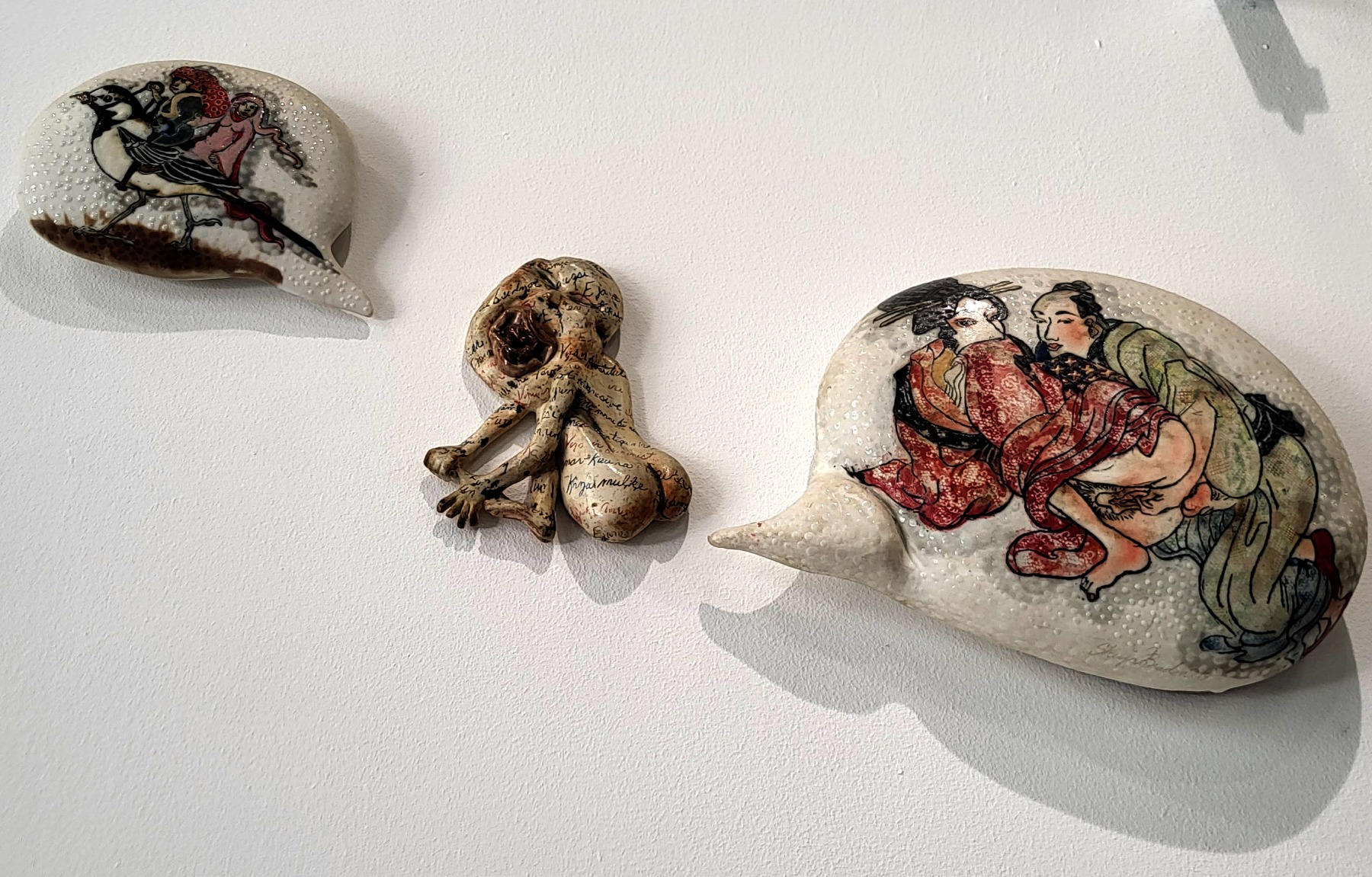
Erotic pictures were used for sexual stimulation in all social strata, as well as for sexual training; for example, they were given to the bride for normal and fruitful sex life. Shunga art was anatomically very detailed, introducing different body types, and included advice on both positions and aids. The works were small-format, intended for viewing in an intimate interior, usually being part of a larger album. The pictures depicted both foreplay, intercourse, and post-intercourse satisfaction; lesbian and gay relationships were presented, but the main focus was on heterosexual relationships, the central characters were men and women aged 20-50, but there were also older and younger ones. There were scenes of everyday married life, young lovers, love affairs, widows, and prostitutes. Different sex poses with penetration and oral stimulation, often a man or a woman masturbating, sometimes also using aids such as a dildo; there were also sex orgies and other fantasy-filled scenes primarily based on the desire to discover. The “rendezvous” could take place in public places such as stairs, gardens, porches, or nature. Contrary to the common understanding brought to us through the geisha culture, in Shunga’s works, women’s sexuality and desire were equal to men’s.
Photo of Skuja Braden’s installation, “Dangerous Liaisons.” In the dangerous waters characteristic of Shunga art, two women float on a thin pink inflatable mattress surrounded by sharks, with the sunset shining in the background. The women cling to each other, undisturbed by the dangers around them; the work shows the warmth and intimacy of a pair of lovers typical of shunga art. The artists have said in an interview that they feel like this living as a duo of well-known artists in Latvia.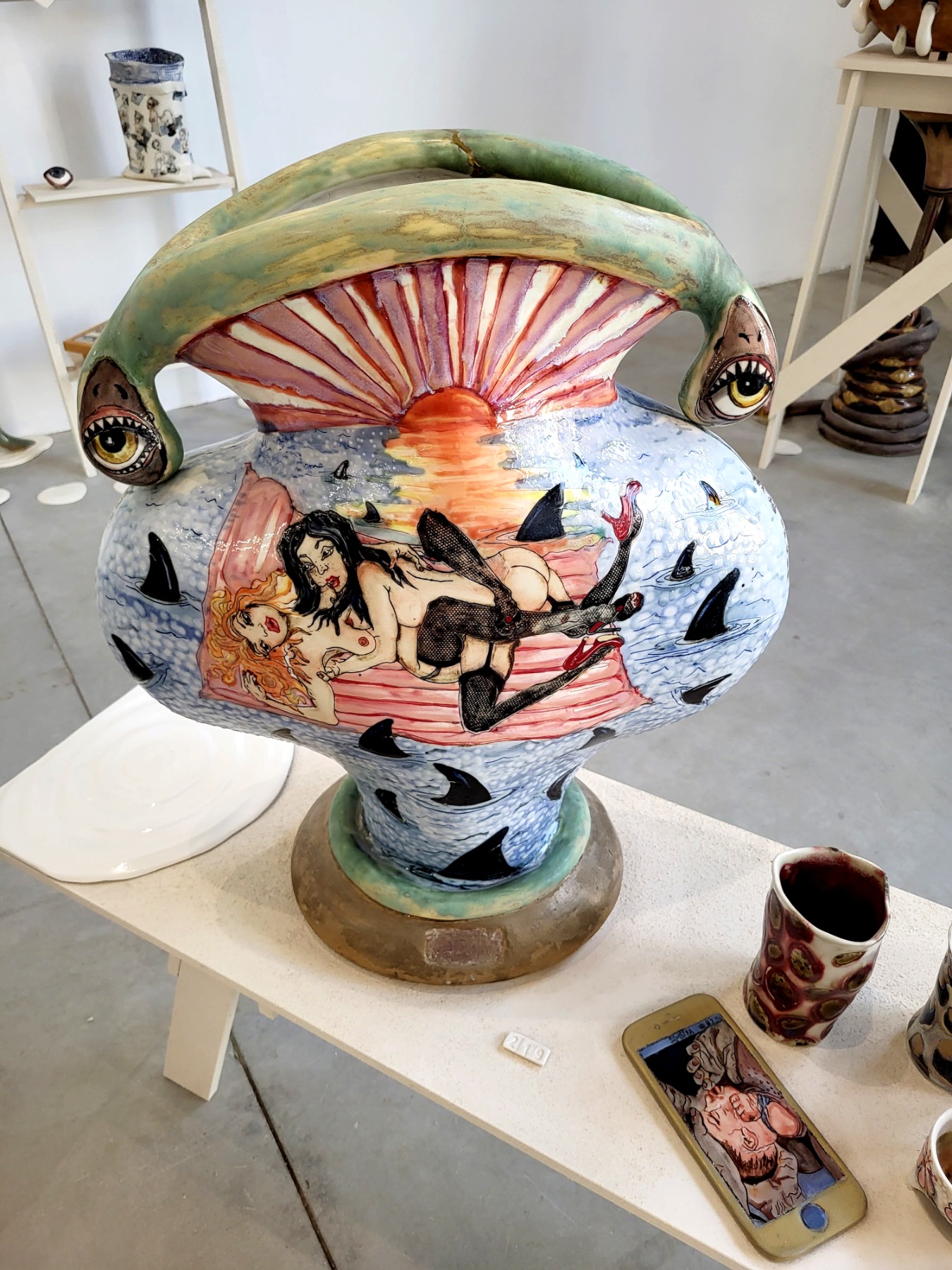
At home, sex was considered the key to harmonious coexistence, and women were the main buyers. However, the shunga artists were men, except for Oi, the daughter of the famous Hokusai, so most of the scenes are from male fantasy worlds.
Being a part of an earlier culture, in shunga art, the genitals formed the “energy center” of the composition of the work in an enlarged form, and everything else aligned around it. In the culture of that time, the naked body did not have as much erotic meaning as clothed characters - the role of clothes was very large, and they defined the characters, giving the works a narrative. Shunga’s light mocking humor was added to the image with text - it is a style typical of the time, where text and visuals were integrated. The narratives or poems referred to Japanese and Chinese history and mythology and played on the viewer-reader’s erudition. Referring to the drollery of the contemporary elite, the texts were filled with idioms and slang and were based on sexual lust. Texts, clothes, and hairstyles helped to interpret the position of the people in the picture and created a narrative for the work.
About the works of Skuja Braden’s installation
Skuja Braden does use the handwriting typical of shunga art but in its own way. Parts of Latvian national culture and a recognizably American pin-up style are certainly woven into their work, but not only that - you can find references to different cultures of the world, and the harsh politics of the day know no national boundaries.
Fabergé eggs
The eggs, reminiscent of the world-famous Russian imperial bejeweled Fabergé eggs, sit in a military cartridge box on the edge of the Lord’s Supper table. Some eggs have got beautiful facial expressions; others have only agape mouths; some have tongues hanging out, and some eggs are completely white as if they are still waiting for meaning. At the same time, the shunga culture adds another aspect to work. Namely, totems that were attached to the belt of the traditional Japanese robe were common in the shunga culture. When opened, this small multi-chamber container contained various sex scenes, which were supposed to bring good luck to the wearer.
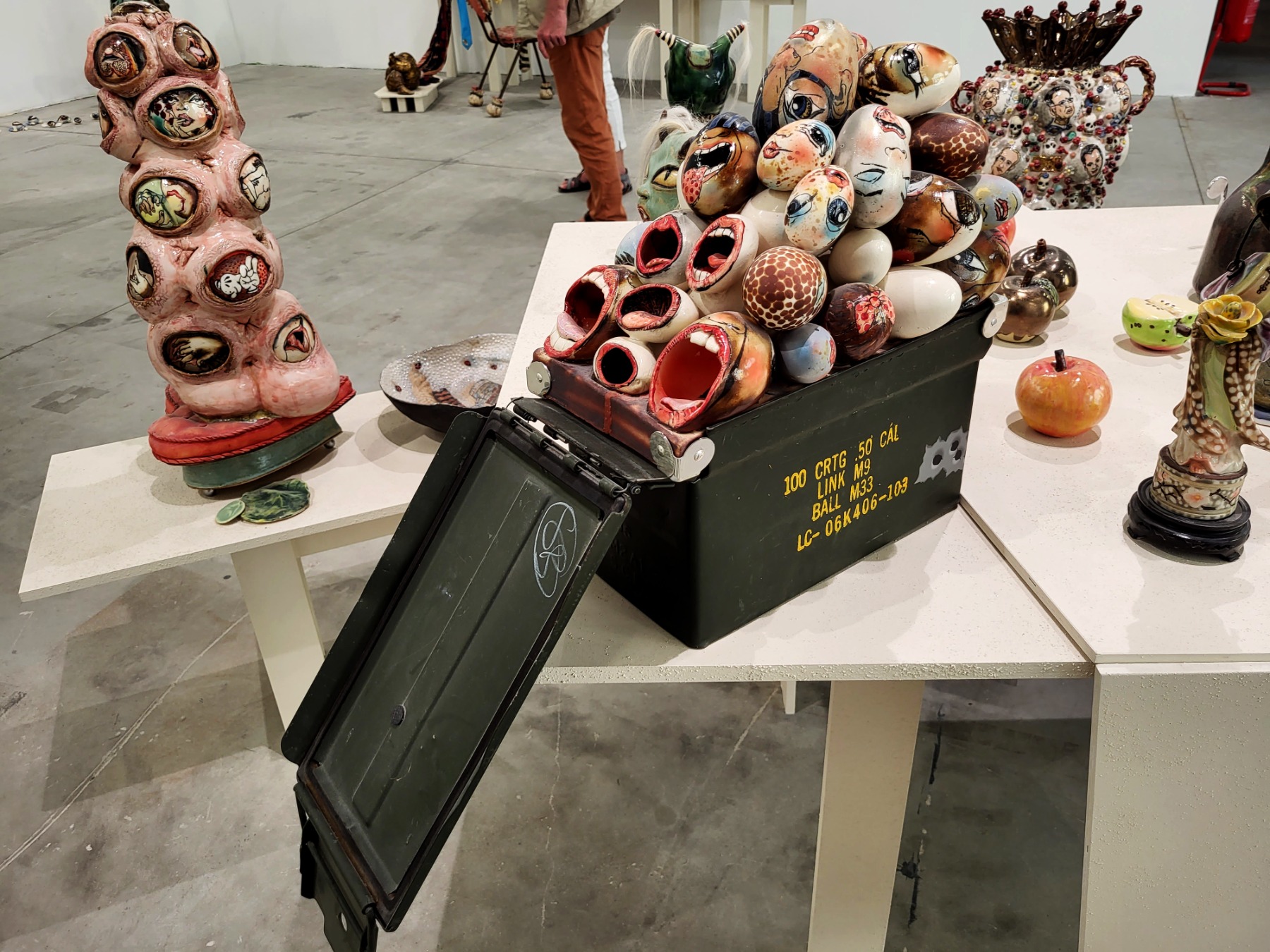
Vase with Vladimir Putin’s face “Then and Now.”
The work was completed after the annexation of Crimea in 2014, which is also considered the beginning of the second Cold War. The vase is lying on its side on the floor, and skulls flow out of the vase instead of water. Next to the vase is a mobile phone with the image of a phallus. Has male-centric culture made the world so skewed? The work also refers to the history of the aggressor against smaller Eastern European countries during and after the collapse of the Soviet Union.
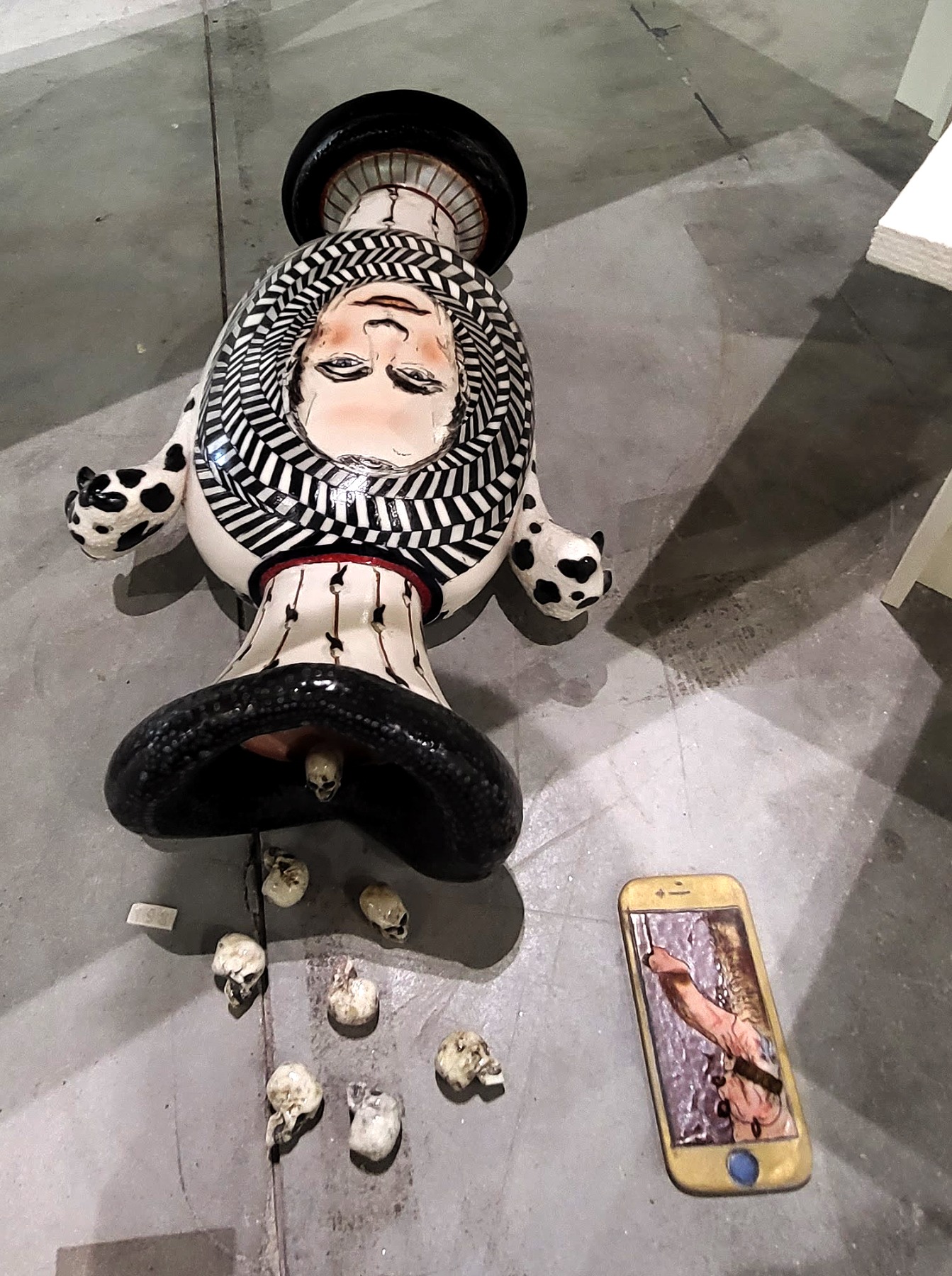
About the openness of society and the change of views
The symbol of the phallus has been important across cultures and has had an empowering and lucky meaning. We hope that through such exhibitions, our worldview will expand, and we will see the world from less extreme points of view and be able to observe the surroundings, taking into account different eras, cultures, and points of view.
The artist Sandra Jõgeva went to Italy and, as a gift, brought me a light blue silk scarf decorated with large phalluses. On the one hand, it seems that the ice is melting, and society is becoming more tolerant and open, one of the most important components of which is good humor. On the other hand, Europe has not faced direct armed conflict since World War II, and the level of aggression in society is extremely high. In the name of a more open, friendly, and cultured society, I hope that the sense of humor will not disappear even in extreme times and mutual understanding is shared even in the face of oddities.
***
Used literature:
Buckland, Rosina. Shunga: Erotic Art in Japan. British Museum Press, 2010.
Interviews with artists, Latvian Pavilion press material
* Andra Orn, curator, and leader of the NOBA.ac art environment